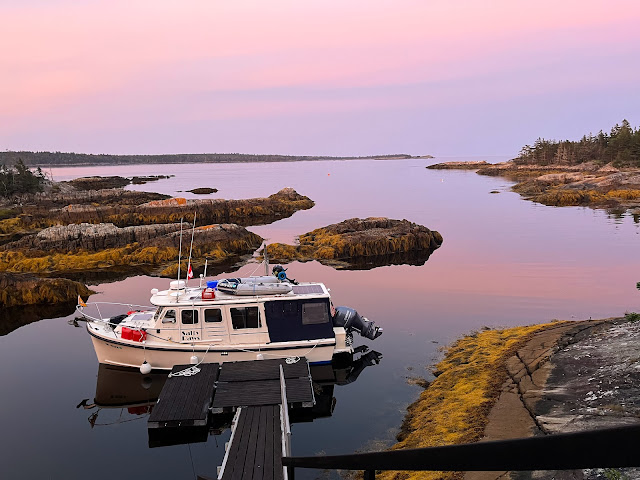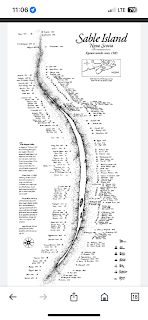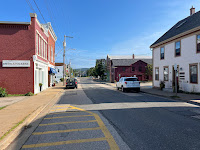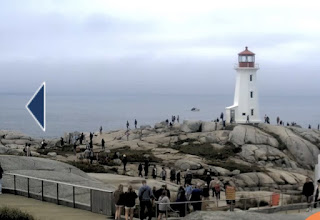Halifax
 |
| Panorama view of one of the cruise ships in Halifax Harbor. |
 |
| Salty Paws in busy Halifax Harbor. |
 |
| The Halifax waterfront has a mile boardwalk along the docks and is lined with restaurants and shops. |
 |
| Picture taken at the Maritime Museum |
Twenty minutes after the initial collision the Mont-Blanc exploded with a violent chemical reaction, releasing energy at 5,000 feet per second. Almost 2,000 people died immediately and another 9,000 were injured. 1,630 homes were completely destroyed, 12,000 houses were damaged and over 6,000 survivors were homeless. Many of the windows throughout the city were shattered leaving many blinded and many in need of surgery to remove glass embedded in their eyes. The blast also created a local tsunami that wiped out a nearby community of the Mi’kmaq First Nation, that had existed for generations.

Halifax today is one of the fastest growing cities in North America and has a population approaching 400,000. The British founded Halifax in 1749 and made the city its base for naval operations in North America. There were at least three reasons for this decision - the port is large, ice-free year round and close enough to counter the French fleet in Louisburg, located roughly 200 miles to the east.
 |
| We walked to the Citadel, a fort that has been rebuilt 4 times and protected the city for 200+ years. |
At the Maritime Museum we learned that in 1758 the British surprised the French in Louisburg leading in short order to the French surrender there. By 1763 the French had acceded all of Canada to the British. Even after that, however, the British continued to have a large garrison in Halifax to guard against the upstart colonists and then the new United States. In fact, for well over 100 years the Americans and the British viewed the other as the enemy.
The city continues to be a large shipping port, and the harbor is lined with a cruise ship berth, a large container facility and more. The old wharves have been fully rehabbed and floating docks added for recreational boats. Every 30 feet of dock has a reservation sign showing the boat’s name, length and dates reserved. Unfortunately, the wharf reservation system is questionable as they do not take same day registrations, payment is only upon departure, and the majority of the reserved slips were empty.
We were able to find one slip with an expired reservation date. I tried to pay the dock fee over the telephone, but was told that they couldn’t take payment but would call back later. (They never did.). Soon, we experienced the downside to this perfect location - boat wakes in the harbor. Between the wakes and the partying (it was their Labor Day weekend), we didn’t get much sleep that night.
LaHave and Lunenburg
 |
| Salty Paws at Anne Huntington’s Bell Island dock. |
 |
| The LaHave Bakery and dock. |
 |
| Anne Huntington and Dick. |
The LaHave Islands are beautiful, and we were blessed to be able to dock for the night and have a home-made dinner with Dick’s friend Anne Huntington at her house on Bell Island. This was followed by two nights at LaHave Bakery, only a 5 minute walk from Molly and my friends, Merydie and Ken Houldsworth. We first met them in the Bahamas in 2016.
The LaHave Bakery along with a bookstore, consignment store and restaurant are all located in the restored LaHave Outfitters building that once served the now almost gone local fishing industry. They have a dock where cruisers can dock free during the day or spend the night for $1 per foot.
 |
| Merydie and Ken. |
 |
| The Bluenose II |
Merydie and Ken hosted us for cocktails and dinner, and Ken drove us to Lunenburg with its UNESCO designated world heritage site on its waterfront. We toured the Fisheries Museum and walked aboard the famous Bluenose II.
The story of the boat is quite a tale, and started in 1920 when the Halifax Express newspaper offered a $4,000 prize for the fastest fishing vessel in a best two out of three races called the International Fisherman’s Cup Race. To be eligible a vessel had to have fished in the Grand Banks for at least one season.
 |
| This topographical map in the Fisheries Museum shows the various fishing banks off the New England and Atlantic Canada. The Grand Banks is off Newfoundland on the far right. |
Elimination races were used off Halifax to determine the Canadian vessel and off New Gloucester, MA to pick the American representative. To the surprise and consternation of the Canadians, the New Gloucester boat won the inaugural cup. The Canadians then engaged in a crash course to design, build and fish in a new boat o qualify for the 1921 race. The boat was constructed in Lunenburg and finished in less than 6 months. It was named the Bluenose, the nickname for people from Nova Scotia. After easily winning the elimination races to represent Canada, Bluenose won both races against the US representative and returned the Fisherman’s Cup trophy to Canada. The boat also won the subsequent Fisherman’s Cup races in 1922, 1923, 1931 and the last one in 1938. The age of sail was now completely over for commercial vessels as sails were replaced by steam engines.
 |
| Dick aboard the Bluenose II. |
The Bluenose was a tremendous source of pride for Canadians and appeared in postage stamps and on the back of their dime. It was sold in 1942, however, and met its demise in 1946 after hitting a reef off Haiti. In 1963 the Orlando Brewery financed the construction of the Bluenose II to be used as a promotional yacht. It was given to the provincial government in 1971 and continues to sail out of Lunenburg as an Canadian ambassador.
Nova Scotia Fog
 |
| Cape Sable Light. The fog lifted temporarily to give us a great view. |
 |
| Our view from the boat while cruising from the Nova Scotia southwestern coast to the Bay of Fundy. |
 |
| You can not read the ship names, but each line is a wreck. |
Almost 40 years ago my father, a friend and I sailed from Portland to Nova Scotia. We arrived in fog, the Province’s 48th straight day of fog. The cold waters of the Atlantic and moist southerly are a perfect recipe for fog. Until this week we have had very little fog on this trip, but it arrived in earnest on our day to round Cape Sable, sometimes referred to as “the Graveyard of the Atlantic.” Hundreds of vessels have run aground on its shoals, so a clear view is most desirable.
 |
| We went by the Cat in Yarmouth before it left on its daily run to Bar Harbor, ME. |
Unlike the ships of the past, however, we have modern technology on Salt Paws including two depth sounders and two independent chartplotters using Global Positioning System (GPS) that show our speed, direction and exact location on the water. Another great advancement is our Automated Identification System (AIS) that displays the position of nearby boats right on our chartplotter, and other boats can see us. AIS is generally required on commercial vessels, and most cruisers also have the system. We also blow our fog horn frequently.
We left our anchorage at Cape Negro Island across from Squaw Island (they still have these names?), and Dick and I swapped 1 1/2 hour shifts at the helm. We would go crazy if we had to pilot boats in these conditions every day. As Salty Paws approached Cape Sable, the fog lifted temporarily and sunlight radiated off the beautiful lighthouse. After rounding the dangerous shoal, we soon found ourselves in fog again. Twice we passed other boats only 0.2 miles away, but we never saw either of them.
Annapolis Royal
 |
| Salty Paws on one of fishing boat mooring at Annapolis Royal, |
 |
| When we walked into the town on Sunday morning, there was no one around. We felt like we were on a movie set. |
Dick and I toured Fort Anne here which was Canada’s first national historical site. As in other historical sites we visited, we learned more about the expulsion of the Acadians and also the treaties made with the Mi’kmaq that were not honored by the British.
 |
| Salty Paws is that little boat out there. |
This is one of the top tourist attractions in Nova Scotia because of its picturesque lighthouse and quaint small harbor. There are two live webcams there, and a Salty Paws was captured by both. I observed 5 large busses in the parking lot.
 |
| Salty paws is in the center of the picture. |


The adventure continues - glad you have all the gear you need to stay safe!
ReplyDelete